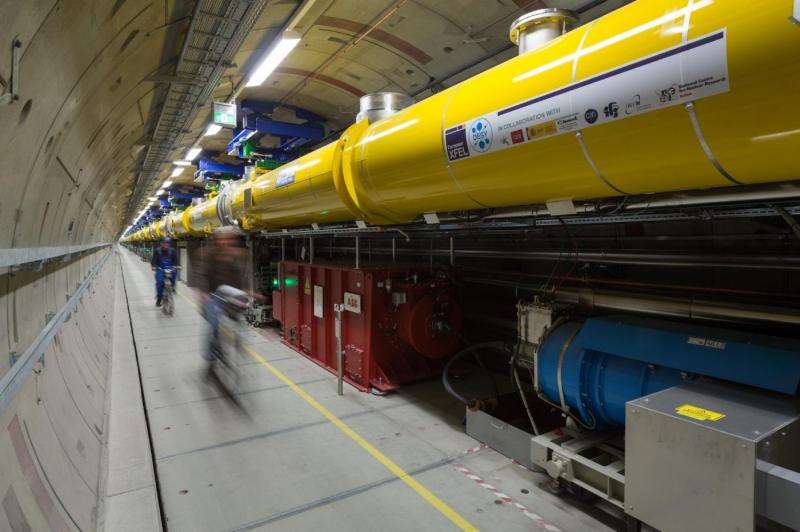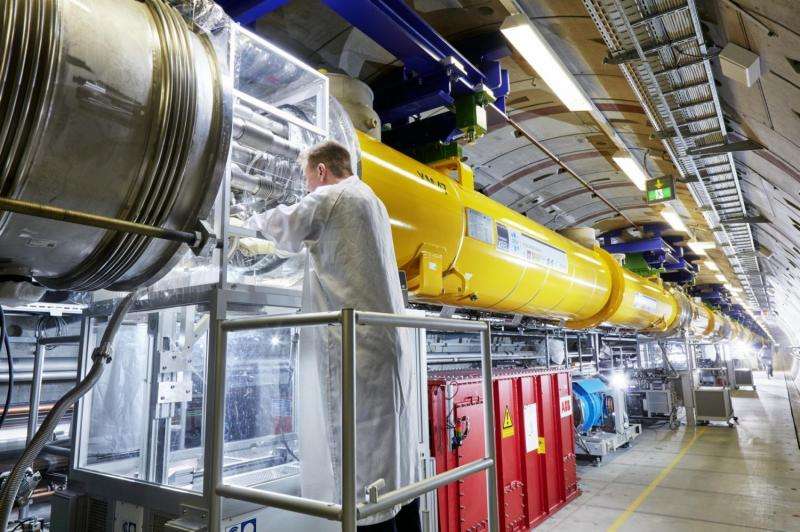Superconducting part of the European XFEL accelerator ready

An important milestone in the construction of the X-ray laser European XFEL has been reached: The 1.7-km long superconducting accelerator is installed in the tunnel. The linear accelerator will accelerate bunches of free electrons flying at near-light speed to the extremely high energy of 17.5 gigaelectronvolts. The bunches are accelerated in devices called resonators, which are cooled to a temperature of -271°C. In the next part of the facility, the electron bunches are used to generate the flashes of X-ray light that will allow scientists new insights into the nanocosmos. The European XFEL accelerator will be put into operation step by step in the next weeks. It will be the largest and most powerful linear accelerator of its type in the world. On 6 October, the German Minister for Education and Research, Prof. Johanna Wanka, and the Polish Vice Minister of Science and Education Dr Piotr Dardziński, will officially initiate the commissioning of the X-ray laser, including the accelerator. User operation at the European XFEL is anticipated to begin in mid-2017.
Responsible for the construction of the accelerator was an international consortium of 17 research institutes under the leadership of Deutsches Elektronen-Synchrotron (DESY), which is also the largest shareholder of the European XFEL. The central section consists of 96 accelerator modules, each 12 metres long, which contain almost 800 resonators made from ultrapure niobium surrounded by liquid helium. The electrons are accelerated inside of these resonators. The modules, which were industrially produced in cooperation with several partners, are on average about 16% more powerful than specified, so the original goal of 100 modules in the accelerator could be reduced to 96.
"I congratulate the accelerator team for this milestone and thank all partners for their perseverance and their tireless efforts", said the Chairman of the DESY Board of Directors Helmut Dosch. "The individual teams involved meshed like the gears of a clock to build the world's most powerful and modern linear accelerator. That all was delivered within a tight budget deserves the utmost respect."

"We are excited that the installation of the accelerator modules has been successfully completed", said European XFEL Managing Director and Chairman of the Management Board Massimo Altarelli. "This is an important step on the way to user operation next year. On this path there were numerous challenges that, in the past months and years, we faced together successfully. I thank DESY and our European partners for their enormous effort, and we look together with excitement towards the next weeks and months, when the accelerator goes into operation."
The French project partner CEA in Saclay assembled the modules. Colleagues from the Polish partner institute IFJ-PAN in Kraków performed comprehensive tests of each individual module at DESY before it was installed in the 2-km long accelerator tunnel. Magnets for focusing and steering the electron beam inside the modules came from the Spanish research centre CIEMAT in Madrid. The niobium resonators were manufactured by companies in Germany and Italy, supervised by research centres DESY and INFN in Rome. Russian project partners such as the Efremov Institute in St. Petersburg and the Budker Institute in Novosibirsk delivered the different parts for vacuum components for the accelerator, within which the electron beam will be directed and focused in the non-superconducting portions of the facility at room temperature. Many other components were manufactured by DESY and their partners, including diagnostics and electron beam stabilization mechanisms, among others.
In October, the accelerator is expected to move towards operation in several steps. As soon as the system for access control is installed, the interior of the modules can be slowly cooled to the operating temperature of two degrees above absolute zero—colder than outer space. Then DESY scientists can send the first electrons through the accelerator. At first, the electrons will be stopped in an "electron dump" at the end of the accelerator, until all of the beam properties are optimized. Then the electron beam will be sent further towards the X-ray light-generating magnetic structures called undulators. Here, the alternating poles of the undulator's magnets will force the electron bunches to move in a tight, zigzagging "slalom" course for a 210-m stretch. In a self-amplifying intensification process, extremely short and bright X-ray flashes with laser-like properties will be generated. Reaching the conditions needed for this process is a massive technical challenge. Among other things, the electron bunches from the accelerator must meet precisely defined specifications. But the participating scientists have reason for optimism. All foundational principles and techniques have been proven at the free-electron laser FLASH at DESY, the prototype for the European XFEL. At European XFEL itself, the commissioning of the 30-m long injector has been complete since July. The injector generates the electron bunches for the main accelerator and accelerates them in an initial section to near-light speed.
The beginning of user operation, the final step in the transition from the construction phase to the operation phase, is foreseen for summer 2017.
Provided by Helmholtz Association of German Research Centres



















